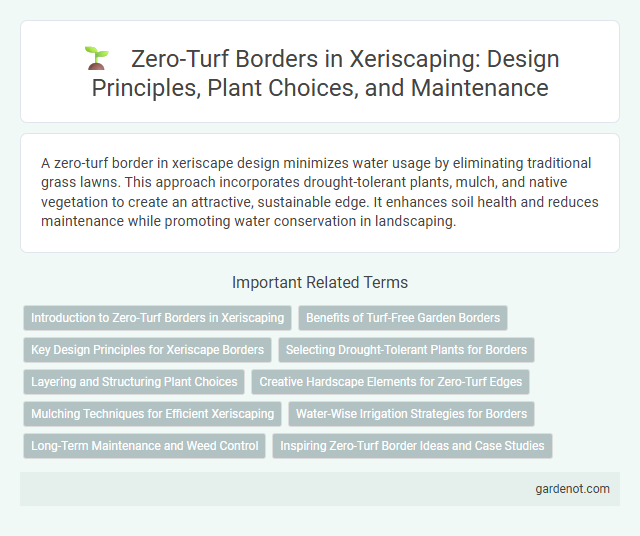A zero-turf border in xeriscape design minimizes water usage by eliminating traditional grass lawns. This approach incorporates drought-tolerant plants, mulch, and native vegetation to create an attractive, sustainable edge. It enhances soil health and reduces maintenance while promoting water conservation in landscaping.
Introduction to Zero-Turf Borders in Xeriscaping
Zero-turf borders in xeriscaping offer water-efficient landscaping solutions by eliminating traditional grass lawns, reducing irrigation needs significantly. These borders utilize drought-tolerant plants, mulch, and permeable materials to create aesthetically pleasing, low-maintenance edges that conserve water and improve soil health. Incorporating native and adapted species in zero-turf borders enhances biodiversity while supporting sustainable land use practices in arid and semi-arid environments.
Benefits of Turf-Free Garden Borders
Zero-turf borders in xeriscaping drastically reduce water consumption by eliminating traditional grass edges, promoting sustainable landscaping. Turf-free garden borders enhance biodiversity by creating habitats for native plants and pollinators, improving ecosystem health. Maintenance costs and labor decrease significantly as these borders require less mowing, watering, and fertilizing compared to conventional turf edges.
Key Design Principles for Xeriscape Borders
Zero-turf borders in xeriscaping emphasize water conservation by eliminating traditional grass edges and incorporating drought-tolerant plants and permeable materials. Key design principles include selecting native, low-water-use species, creating smooth transitions between zones, and using mulch or gravel to reduce evaporation and suppress weeds. Integrating curved lines and layered vegetation enhances aesthetic appeal while maintaining functional water efficiency.
Selecting Drought-Tolerant Plants for Borders
Zero-turf borders enhance water conservation by eliminating traditional grass edges and incorporating drought-tolerant plants such as lavender, sedum, and ornamental grasses. Choosing native species like agave or yucca ensures deep root systems that thrive in arid conditions while reducing irrigation needs. Xeriscape design principles emphasize soil preparation and mulch application to retain moisture and support plant health in border areas.
Layering and Structuring Plant Choices
Implementing a zero-turf border in xeriscape design emphasizes layering and structuring plant choices to maximize water efficiency and aesthetic appeal. Utilizing drought-tolerant shrubs, succulents, and ornamental grasses arranged in graduated heights creates visual depth while reducing irrigation needs. Strategic placement of mulch and native groundcovers further enhances moisture retention and soil health in arid landscapes.
Creative Hardscape Elements for Zero-Turf Edges
Creative hardscape elements for zero-turf borders include decorative gravel, permeable pavers, and natural stone, which enhance both aesthetics and functionality. These materials reduce water consumption while providing durable, low-maintenance edges that define garden spaces effectively. Incorporating features like raised beds, metal edging, or mosaic pathways can further emphasize design creativity without relying on traditional grass turf.
Mulching Techniques for Efficient Xeriscaping
Zero-turf borders in xeriscaping significantly reduce water consumption by eliminating grass and replacing it with mulching techniques such as organic bark chips, gravel, or decomposed granite. Mulching conserves soil moisture, suppresses weed growth, and stabilizes soil temperature, enhancing plant health in dry landscapes. Proper application thickness, typically 2 to 4 inches, optimizes water retention and soil protection in zero-turf xeriscape designs.
Water-Wise Irrigation Strategies for Borders
Zero-turf borders utilize drought-resistant plants and mulch to minimize water consumption while maintaining aesthetic appeal. Water-wise irrigation strategies such as drip systems and smart timers target roots directly, reducing evaporation and runoff. Integrating soil moisture sensors further optimizes watering schedules, conserving water without compromising plant health.
Long-Term Maintenance and Weed Control
Zero-turf borders significantly reduce long-term maintenance by eliminating the need for regular mowing, fertilizing, and watering associated with traditional grass lawns. These borders use drought-tolerant plants and organic mulch that suppress weed growth effectively, minimizing the reliance on chemical herbicides. Over time, this approach promotes sustainable weed control and lowers overall landscape upkeep costs.
Inspiring Zero-Turf Border Ideas and Case Studies
Explore inspiring zero-turf border ideas that showcase drought-tolerant plants, native grasses, and permeable materials to create sustainable, low-maintenance landscapes. Case studies highlight successful xeriscape designs incorporating succulents, ornamental grasses, and mulching techniques, reducing water usage by up to 50%. These innovative borders enhance curb appeal while promoting water conservation and biodiversity in arid environments.
Zero-turf border Infographic

 gardenot.com
gardenot.com